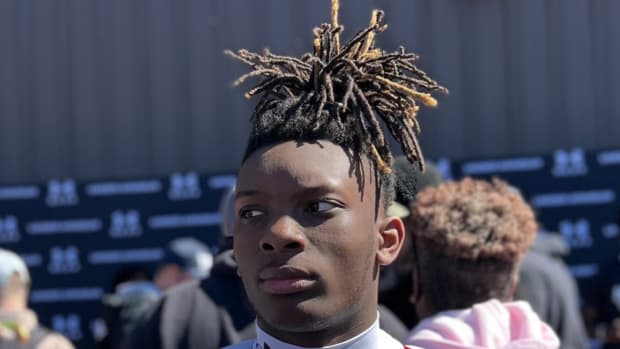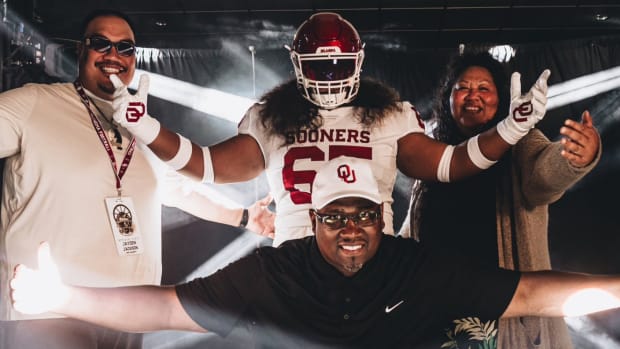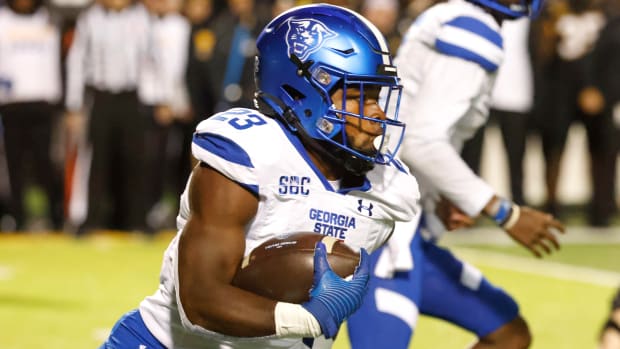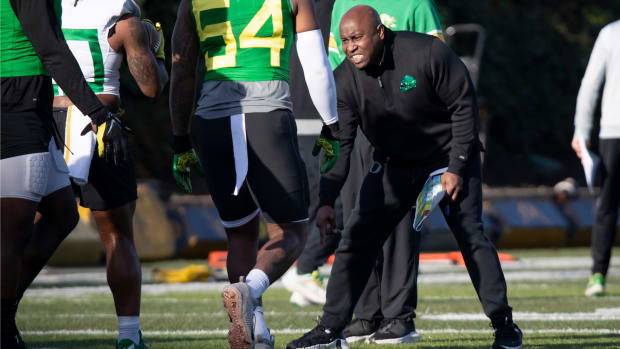The Double-Edged Sword of the Transfer Portal
A player recently went to an employee of the Power 5 football program he plays for and asked to go into the NCAA’s new transfer portal. The player’s request was granted, because the school can’t say no when a player wants to enter his name into the database that announces to other schools that the player wishes to be recruited as a transfer.
But before the player entered his name, the people in the program warned he might not find what he seeks. There has been a flurry of transfer activity since the schools changed the NCAA rules that allow schools to block players from transferring to certain other schools on an athletic scholarship. School officials are so worried about undergraduate transfers gaining immediate eligibility—they’re supposed to sit out a year under current rules—through NCAA waivers that the NCAA’s transfer working group is now examining changing the waiver guidelines it issued only last year. A tighter waiver process for undergrads might slow the flow into the portal, but no matter what happens with the waivers, the portal isn’t going anywhere. Athletic directors and school presidents got tired of ADs and coaches being portrayed as control freaks when they tried to block transfers (because they’re control freaks), and they aren’t going to fight a p.r. battle that they’re going to keep losing. So far, the players actively seeking new schools have found homes. But in the next few months, a harsh mathematic reality is going to set in that could leave players stuck in the portal with no new school and no old school.
STAPLES: Who Will Be the Next First-Time Playoff Team?
The player mentioned above is younger and has yet to contribute to the program on the field. (We’re not naming the him or the program to avoid embarrassing him as he deals with a tough decision.) He wouldn’t mind going to a Group of Five program, which isn’t unusual now and wasn’t unusual before the rule changed. The coaches in his current program wouldn’t be terribly upset if he transferred, because it would free up a scholarship for a player who might contribute more quickly. But contrary to popular belief, not everyone who works in college football is completely heartless. This staff wanted to help the player find the situation that worked best for him. A staffer reached out to a Group of Five program near one of the players’ hometowns and asked a question that will get asked frequently in the next few months.
Got any initials?
In NCAA parlance, an initial counter is a new scholarship player at a school. In football, a school can take up to 25 initial counters each academic year as long as it doesn’t go over the 85-scholarship maximum. This rule exists for several reasons:
• To keep teams from stockpiling the best players.
• To keep teams from oversigning and shuffling out less productive older players to cover their recruiting mistakes.
• To keep a new coach from running off an entire team so he can replace the players with his own recruits.
A scholarship player signed out of high school counts as an initial. So does a junior college transfer. And so do transfers from four-year schools—be they undergraduates or graduate students. The Group of Five school our Power 5 staffer contacted had bad news: We’re full up.
In other words, that school already had 25 initial counters joining the team for the 2019–20 academic year. That potential transfer would have to look elsewhere. Across the country this month, players are going to start spring practice and frown when they realize where they sit on the depth chart. They are going to be intrigued by the possibility of transferring, and the freedom afforded by the new transfer rules makes it easy to toss their name into the portal. But they need to evaluate their situation very carefully before they do that, because there probably aren’t going to be enough available scholarships for all the players who want to transfer.
This is not a criticism of the new transfer rules. In fact, they are pretty much exactly the rules I laid out in this very column years ago. These changes needed to happen. The power dynamic was tilted too heavily in favor of the coaches for far too long. The players had a right to this small bit of control over their own careers. This merely is a warning to those players that anyone with newfound power needs to hear. And the person who said it better than anyone is Spider-Man’s Uncle Ben: “With great power comes great responsibility.”
Here’s why players need to make a raw, honest evaluation of their situations before they enter the portal. Once a player enters the portal, the player’s current school is under no obligation to keep that player on scholarship. After all, a man can’t leave the house and tell his wife he’s going on a few dates that night and reasonably expect her to still let him sleep in her bed. Most programs sign so many players that if everyone comes back for next season, that program will be over the 85-scholarship limit. Attrition—players getting booted, players retiring, players transferring—always seems to get programs to 85, but there is no reason a coach couldn’t just zap the players in the portal to get to the number. This potential transfer described above appears prepared to stay at his original school, which is willing to take him back. That likely means the coaching staff is holding out hope for a potential contribution and that coaches just like the guy. But if a player isn’t contributing and a problem in the locker room, his coaches may be praying this spring that he hops into the portal so they can cut him loose with no potential blowback.
There has never been a group less qualified than college football coaches to complain about other people seeking greener pastures. As a group, college coaches are frequent job hoppers who routinely leave their players in a lurch when a better opportunity comes along. So the coaches need to suck it up and quit whining about the power given to the players by the new transfer rules. The coaches brought this on themselves, and they are more than adequately compensated to deal with the complications that arise from the players having a little freedom of movement. The smartest coaches will not complain, anyway.
They will see this as an opportunity, because the power is about to swing back in their direction as programs analyze their scholarship situations. Nebraska coach Scott Frost recently said he kept a few scholarships in his back pocket for potential transfers. Miami’s Manny Diaz explained how he is using the transfer portal to restore class balance in Coral Gables. But even the coaches who had the foresight to stash some scholarships because of a potential bump in the transfer population didn’t store that many. There will be less FBS scholarships available than there are FBS players in the portal, which means those coaches with scholarships can afford to be choosy and grab only players who either can fill an immediate need or who project as future stars with a little seasoning. Everybody else? They can just leave them in the portal.
The Top 10 Vacated Games in College Football History
And that’s where the players must be careful. A player unhappy with his place on his team this spring needs to find someone he trusts to be honest—not someone who will tell him what he wants to hear. He might need to have a high school coach do some back-channel interest-gauging to ensure there will be a market for him should he decide to transfer. (Which sounds an awful lot like the old transfer system, except the back-channel conversations then were about making schools aware of a potential transfer as well as ensuring they had free scholarships. Now the portal takes care of the awareness part.) He may find out that he has a chance to play just as quickly by staying put. He also may learn that his particular talents aren’t as valuable as he thinks.
Before the transfer rules changed, a player had to know all this before he declared his intention to transfer. Now? He can just hop into the portal. But he needs to be careful lest he get stranded there when no new school has enough of the 25 and his old school needs to get down to the 85.
A Random Ranking
Sometimes we just need a cup of hot tea at the end of a long day. Here are the top 10 varieties.
1. Peppermint
2. Orange Spice
3. Green
4. Chamomile
5. Jasmine
6. Peach Oolong
7. Apple Cinnamon
8. Constant Comment
9. Earl Grey
10. English Breakfast
Three and Out
1. BREAKING: Quarterback Jalen Hurts is still strong after transferring from Alabama to Oklahoma.
2. SI’s Ross Dellenger spent two days with Les Miles, who has gone vegan, strapped on an Apple Watch and taken on one of the toughest jobs in the Power 5.
3. You always wanted to see Oklahoma State coach Mike Gundy dance to Flo Rida, didn’t you? Thanks to SiriusXM DJ Mary Carlisle Callahan, now you can.
What’s Eating Andy?
Maybe Kyler Murray shouldn’t be the only two-sport QB in the draft.
What’s Andy Eating?
If you keep scrolling down, you will soon see a photo of a piece of carrot cake with a bite missing. I apologize for this—to a point.
I went to Hangry Al’s in Miami to eat sandwiches, because Hangry Al’s is a sandwich shop. Al Benavides, who used to get hangry frequently as a kid, runs the place. His father Emilio, who confirmed that Al could get irritable when hungry as a kid, helps on the grill and behind the counter.
Al’s mom Elizabeth makes the meatballs for the meatball subs using only 93% lean ground beef—over the profit margin–related protests of her son and husband—because she doesn’t want to replace melted fat with filler. Elizabeth also makes carrot cake, which is underselling the point because Elizabeth’s carrot cake might be the best carrot cake on earth.
Normally, I photograph everything I eat when I think the place might be worth a review in this column. But I’d already shot the meatball sub and the hot corned beef and pastrami with swiss on rye that wasn’t on the menu but was happily whipped up anyway. These were delicious, and I figured I didn’t need anything else to recommend this shop about three miles from the University of Miami’s campus. But Emilio had told me I’d regret not buying the last slice of carrot cake on this particular Wednesday, and because I am a sucker for carrot cake, I believed him.
After devouring two sandwiches, I’d planned to take dessert with me. But that carrot cake called to me. So I took a bite. Sweet and tangy carrots and cinnamon and nutmeg combined with the bite of cream cheese frosting to create a sugar bomb in my mouth. I had to eat the rest, but first, I had to take a picture to show you exactly what you need to get should you find yourself in Hangry Al’s. It is an imperfect photo of a perfect piece of cake. The rest didn’t last long. As I inhaled it, Emilio and Al could only laugh. Al asks his mom to make this cake for his birthday every year. I could tell this was more moist than any carrot cake I’d eaten, but I couldn’t figure out what else seemed different. After the last bite had disappeared, the men explained that Liz doesn’t use nuts or raisins in her cake. Like her meatballs, she prefers an all-killer, no-filler philosophy.
My reaction struck me as odd. I like the nuts and raisins in carrot cake, but this seemed so much better than the other slices I’d had. Perhaps it was a case of addition by subtraction. No matter the reason, make sure you secure a slice of carrot cake even before you order your sandwiches at Hangry Al’s. Because if I happen to be coming the same day, I’m buying it all.







